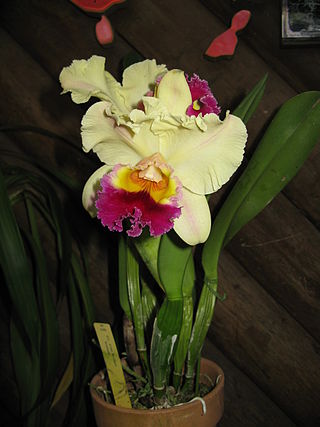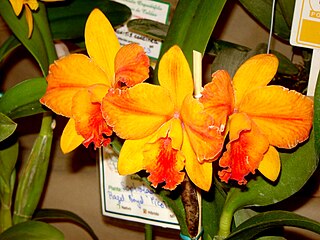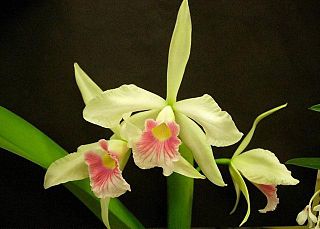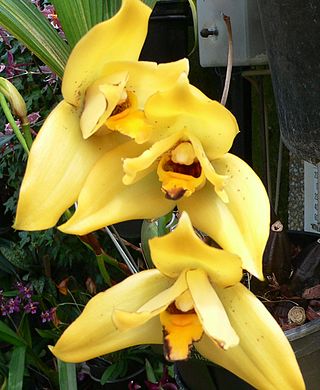
Orchids are plants that belong to the family Orchidaceae, a diverse and widespread group of flowering plants with blooms that are often colourful and fragrant. Orchids are cosmopolitan plants that are found in almost every habitat on Earth except glaciers. The world's richest diversity of orchid genera and species is found in the tropics.

The Royal Horticultural Society (RHS), founded in 1804 as the Horticultural Society of London, is the UK's leading gardening charity.

Cattleya is a genus of orchids from Costa Rica south to Argentina. The genus is abbreviated C in trade journals.

Laelia is a small genus of 25 species in the orchid family (Orchidaceae). Laelia species are found in areas of subtropical or temperate climate in Central and South America, but mostly in Mexico. Laelia is abbreviated L. in the horticultural trade.

Prosthechea is a genus of flowering plants in the orchid family (Orchidaceae). The name is derived from the Greek word prostheke (appendix), referring to the appendage on the back of the column. Appendage orchid is a common name for this genus. Prosthechea is abbreviated Psh. in the horticultural trade.

× Brassolaeliocattleya, abbreviated Blc. in the horticultural trade, is the orchid nothogenus for intergeneric hybrid greges containing at least one ancestor species from each of the three ancestral genera BrassavolaR.Br., CattleyaLindl. and Laelia Lindl., and from no other genera.

× Schombocattleya is a historic intergeneric hybrid of orchids since all species of Schomburgkia have been transferred to either Laelia or Myrmecophila. The genus was abbreviated Smbc. in the horticultural trade. Plants of the World Online treats it as a synonym of × Laeliocattleya.

× Sophrolaeliocattleya is a nothogenus of artificial intergeneric orchid hybrids. It is abbreviated as Slc. in the horticultural trade. As of 2008, × Sophrolaeliocattleya is defunct, with the genus Sophronitis having been merged into Cattleya.

Laeliinae is a Neotropical subtribe including 40 orchid genera, such as Brassavola, Laelia and Cattleya. The genus Epidendrum is the largest within this subtribe, containing about 1500 species. This is followed by the genus Encyclia, with over 120 species.

Guarianthe, abbreviated Gur. in the horticultural trade, is a small genus of epiphytic orchids, growing in wet forests in Mexico, Central America, Colombia, Venezuela and Trinidad. It was separated from the bifoliate Cattleyas in 2003, based on phylogenetic studies of nuclear DNA sequence data.

Cattleya purpurata, known in the past as Laelia purpurata and Sophronitis purpurata, is native to Brazil where it is very popular among orchid growers. It is an epiphyte that is found in the canopy of tall trees near coastal areas, in the Brazilian states of Rio Grande do Sul, Santa Catarina and São Paulo. The orchid favors bright light and cool to warm conditions and is relative easy to cultive. C. purpurata has been used extensively as a parent in hybridizing with Cattleyas. Cattleya purpurata blooms from late spring to fall with three to five flowers on a spike. The flowers are long-lasting and fragrant.
Peter Geoffrey Taylor (1926–2011) was a British botanist who worked at Royal Botanic Gardens, Kew throughout his career in botany. Taylor was born in 1926 and joined the staff of the herbarium at Kew in 1948. He published his first new species, Utricularia pentadactyla, in 1954. In 1973, Taylor was appointed curator of the orchid division of the herbarium and, according to Kew, "under his direction, orchid taxonomy was revitalised and its horticultural contacts strengthened."

The term grex, derived from the Latin noun grex, gregis, meaning 'flock', has been expanded in botanical nomenclature to describe hybrids of orchids, based solely on their parentage. Grex names are one of the three categories of plant names governed by the International Code of Nomenclature for Cultivated Plants; within a grex the cultivar group category can be used to refer to plants by their shared characteristics, and individual orchid plants can be selected and named as cultivars.

Cattleya tigrina is a bifoliate species of Cattleya orchid. The diploid chromosome number of C. tigrina has been determined as 2n = 40.

Cattleya walkeriana, or Walker's cattleya, is a species of orchid. It differs from most species of Cattleya by having inflorescences which arise from the rhizome instead of from the apex of the pseudobulb. In its native habitat it grows as either an epiphyte or a lithophyte, sometimes in full sun, at elevations up to 2000 meters. Pseudobulbs are relatively short, bulbous or fusiform, with one or two ovate leaves at the apex. Inflorescence is one- or few-flowered, about 8" (20 cm) tall. Flowers are 4-5" (9-12 cm) across.

Cattleya warscewiczii, a labiate Cattleya, is a species of orchid.

Cattleya crispa is a species of orchid indigenous to the Tijuca Mountains north of Rio de Janeiro, Brazil, noted for its crisped and ruffled petals and lip. It is the type species for both the subgenus Cattleya subg. Crispae and its section Cattleya sect. Crispae.

Isabelia is an orchid genus formed by three tiny species and one natural hybrid, spread from the Northeast of Brazil to Argentina, which are closely related to the genus Constantia. During more than a century Isabelia was a genus formed by just one species, however, around 1968, it was merged with genus Neolauchea, also unispecific. In 2001, a third genus was added to it, Sophronitella. The genus name is abbreviated Isa. in cultivation.
Cássio van den Berg is a Brazilian botanist, noted for work in orchid classification and evolution, especially great changes in the generic circumscriptions of ornamental orchids in the genus Cattleya, based on DNA studies for the subtribe Laeliinae.

Cattleya × elegans is a hybrid orchid in the subtribe Laeliinae. It is a pseudobulb epiphyte. Its formula hybridae is Cattleya purpurata Van den Berg (2008) × Cattleya tigrina A.Rich. (1848). It is found in South and South-East Brazil.


















